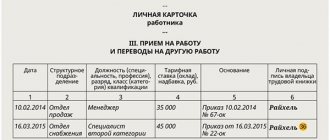A new employee in a company is stressful for both the newcomer and the company. Everything around him is unfamiliar: the office, the product, the team, the technology stack, the processes. You need to adapt to all this and figure it out quickly so as not to torment those around you. The adaptation process can be left to chance. Considering the costs of the HR department, department head, team lead and other employees to find suitable personnel, this is an ineffective approach. When a newcomer realizes that no one is helping him to join the team, he will simply leave during the probationary period. If it remains, adaptation will take too long, and no one controls it.
Therefore, it is important to set up the adaptation process. A well-functioning system saves time and resources for the company and employees, allows you to get a newbie up to speed as quickly as possible and start getting results from him.
An adaptation checklist will help you set up the system. It contains key aspects of adaptation at different stages of introduction to a position: adaptation zones, what skills a newcomer should learn and in what sequence, a mentoring system, certification and feedback. Alexey Petrov will tell you more about what a checklist is and how it works.
(pifagor_mc). Alexey - Head of QA department FunCorp, conference speaker, author of testing courses. In IT since 2005, managing since 2010. Worked his way up from junior tester to quality director.
And here it is again, onboarding
As Head of QA department, I regularly hire people, and the question of their adaptation also regularly arises. But not only I, but also other companies ask this question when they need to move a new employee into the current reality. The issue of onboarding is now on the wave of popularity.
Why is this happening?
Finding IT specialists is difficult.
This is due to the demographic situation, great competition, high demand for specialists and their cost, and the outflow of people to other countries.
All these reasons delay the search for specialists. A recruiter or HR spends several months on hiring
: proofreading HeadHunter, LinkedIn, My Circle, invitations and interviews.
But this situation is not catastrophic. A disaster is losing a person
when they finally found him: he went to work and after 2 weeks he left due to stress.
I have been onboarding multiple times at different companies. One day he took a director’s position at the Mail.ru holding. As part of onboarding, for some reason I was introduced to two ordinary developers, and a month later both left the company. Then they were afraid to introduce me to anyone else.
In large companies, adaptation is usually carried out by an entire department in the HR structure, and in smaller companies - by department heads and team leads. As a manager, I also participated in this, but the process did not suit me. I began to ask the question: “How to structure and streamline employee adaptation?”
What is it usually adapted to? In basic things: people, everyday issues, product and its market, processes, architecture, company, regulations, traditions, tools. But a newcomer is rarely adapted on all counts, and more often than not everything goes according to one of four classic scenarios.
Typical adaptation
A huge, unreadable document or folder
. This is a long monolithic footcloth that contains all the documents from the beginning of time to the current moment. Another option is an FTP folder with a knowledge base. All this is given with the parting words: “Read!”
Where to start, where to end, how to navigate this? A person gets lost in a scattered knowledge base and becomes even more demotivated. Let me remind you that we hired a highly qualified specialist at a price of six figures.
, which consists of his salary and the man-hours of HR and other colleagues spent on hiring. As a result, the specialist rests on the footcloth. Are you seriously?
List of scattered documents “on request”
. This situation is even worse. For example, an employee has a question:
— What is the life cycle of tasks in our tracker? - Go to Petya, he will show you the documentation. It's lying somewhere, you just can't find it! — How to book a meeting? - Go to Dasha -...?
A new employee needs to ask a question, try to solve it, find someone who knows how to solve it, and only then will they give him some kind of answer. Or maybe they won’t.
Welcome meeting
. This procedure is implemented in various forms in many companies. She was in every second company I worked for for 15 years. What does it look like? HR, sometimes the immediate manager, comes and in half an hour explains how the company works, where you can answer your basic questions, and who to ask what. That's all, continue on your own.
No way
. Many companies do not have an onboarding procedure. One day, I came to the company as a manager, met the team, and we went to lunch together on the first day of work. My immediate supervisor approached us and decided to arrange a “Welcome meeting”. He sits down and says:
- Lesha, this is your team. You are adults, you can figure it out for yourself.
Five seconds and he was gone. This is where the adaptation within the company ended.
It seems that everything is bad. Is it possible to solve the problem?
Plan for entering the position during the probationary period
Acquaintance with employees of other departments with whom the new employee will interact due to the nature of his duties.
Where to start, where to end, how to navigate this? A person gets lost in a scattered knowledge base and becomes even more demotivated.
Instructions for fire safety inspection of the premises at the end of the working day. The procedure for employees of XXX LLC in case of fire, natural disasters and other emergency situations. The procedure for officials to act in the event of an industrial accident at XXX LLC.
Where to start, where to end, how to navigate this? A person gets lost in a scattered knowledge base and becomes even more demotivated.
Instructions for fire safety inspection of the premises at the end of the working day. The procedure for employees of XXX LLC in case of fire, natural disasters and other emergency situations. The procedure for officials to act in the event of an industrial accident at XXX LLC.
Its main task is to quickly and easily introduce a newcomer to the course of business, familiarize himself with the team and job responsibilities.
Studying the package of documents ¦ ¦ ¦ ¦ ¦regulating the work of ¦ ¦ ¦ ¦ ¦company employees: ¦ ¦ ¦ ¦ ¦1.1.
It should be noted that the adaptation process includes several stages, and different companies practice both simplified options and more complex, structured programs.
Do not appoint people who have applied for the position as mentors. They can harm the employee in every possible way, trying to get him to leave the company. Choose only friendly employees who are open to communication, ready to share their best practices and go into all the details of performing their job duties.
The induction plan helps a new employee in the company understand what is required of him in the next three months, and the new employee’s manager can objectively assess the results of the probationary period, based on the work plan, comparing it with the actual situation.
This sample onboarding plan will help you organize and document tasks and responsibilities when onboarding a new employee.
Familiarization with the location of all buildings and structures of the enterprise in the city. 2 Personal or public transport. Plan I.
Let's say you hire a new employee. What would you tell him before he starts his official duties? Write down your thoughts on this matter.
As Head of QA department, I regularly hire people, and the question of their adaptation also regularly arises. But not only I, but also other companies ask this question when they need to move a new employee into the current reality. The issue of onboarding is now on the wave of popularity.
My recipe - adaptation checklist
I've been using it for the past four years.
How did he appear? We decomposed and modified
that same big monolithic footcloth: they divided it into temporary and functional blocks, downloaded additional materials on aspects that were missing, for example, overview stories on the product, market or processes within the company. We either wrote additional materials within the department ourselves, or went to HR colleagues, the product department, or developers so that they could fill in the niches. This is how this checklist was formed.
We requested all documents in advance
and put them in one place - in a checklist with links. It is very convenient when the company has a knowledge base. For me it was Confluence: it allows you to put links, attach files, videos. Without interruption from production, an employee can familiarize himself with the full list of knowledge.
We turned the first Welcome meeting into an iterative event
- with regular feedback.
Let's talk about the nuances of the checklist in more detail.
Checklist cornerstones
These are the moments that determine its structure: publicity, time blocks, clear performance criteria, mentor and feedback.
Mentor
A mentor is attached to the checklist
. This is a guide for a new employee in the company, without him there is nowhere. Sometimes it happens that the immediate supervisor becomes a mentor. But when the team has 10-15 people, the manager will spend an excessive amount of resources on mentoring.
The manager does not have to become a mentor to the newcomer.
Mentoring does not require managerial competencies.
A basic understanding of what and how the company works is enough. If you are a leader, delegate mentoring
. Find empathetic people within the team who are interested in additional people and resources and involve them. They will do a better job than you. For example, like in Mail.ru Group. The company has a whole institute of mentors - a separate caste with its own training. There, the title of “mentor” is honorary.
Publicity
The checklist is public
. Imagine an unhappy newcomer: he is stressed, trying to understand what is happening, does not understand where to grow and what to do within the company. HR or the team lead walks around him, looking sideways and checking off some kind of “checklist”. Absurd? Of course, this is why the checklist is available to both the mentor and the employee. Now at FunCorp we use a practice where the checklist is public and in relation to the team.
Public access increases the level of responsibility of the mentor and the newcomer
. When the entire team sees the progress of a new employee and his path along the checklist, the mentor’s responsibility increases by an order of magnitude.
Involves the mentor and team in the passage
. Here the team is not a supervisor, but an assistant. If someone sees that there is no question about traditions in the checklist, one of the colleagues can say about this: “We have a tradition - every new person is marked with beer on Fridays!” This may be fiction, but this is how he participates in the adaptation of a new employee.
This involves not only one mentor and immediate supervisor, but also the entire team. This is good psychological support for a new person. He understands that these are not isolated people who look askance and tick some boxes, but a team that supports him.
Time blocks
Decompose and conquer
. The checklist is divided into blocks: first week, second, first month, second and third. Inside the checklist, these timelines allow you to break down the footcloth into a list of tasks. It will be strange if, as part of adaptation, in the first week a person tries to understand a complex tool that will only be useful in the third month of work.
The opposite also works - why wait until the third month to familiarize yourself with the restrooms in the office? Although I came across such a situation a couple of times when it was only upon request. The issue of the restroom was a closely guarded secret: no one showed or told, at home you go to the toilet before and after work, but at work you endure it, or try to find out from someone where this “office” is.
Clear chronology of adaptation
. A newcomer goes from simple to complex: first traditions and the product, then he gets to know his product team, then gets the necessary access. When everything is completed, a full-fledged employee is ready, who performs a certain layer of work.
Definition of Done
Obvious and understandable criteria for completing the task
. This is important - it helps to assess that the item has really been completed and the box has not been ticked “for the sake of a box”.
Sometimes there is a temptation between a mentor and a newcomer to enter into a “criminal conspiracy”, to mark an item on a checklist without checking.
- You need to familiarize yourself with some regulations - I saw a list of regulations somewhere in Confluence. I guess I got to know them.
The mentor also thinks:
- Well, I got acquainted, that means I got acquainted.
You shouldn't do that.
During a one-on-one meeting and gathering feedback, I recommend sifting diagonally through the checklist items
. For example, if an employee has sorted out tickets in the tracking system, ask him about key statuses. If you have installed and configured the tool to work, make sure that this is indeed the case. Sifting helps clarify the reality of completing items.
I do not recommend arranging checks like on an examination committee
. You can reach the point of insanity: “Let’s sit down and you will slowly show how you figured out the point of going to the restroom.” Be gentler, remember that you took not a junior, but a professional. He realizes that the checklist is a “guide map.” The employee understands that his own success in the company depends on honest performance. If he is deceitful, he will deceive himself, and not his employer.
One-on-one feedback
At the end of each block
we have one-on-one meetings to get feedback.
Checking the checklist to find out which items have been completed
. Ideally, by the end of the reporting period, all items should be completed. This is an indicator that the new team member has acquired the necessary knowledge, skills and competencies.
This is also a good opportunity to talk to a person
about what he likes or doesn’t like about the job, the team, and the company. In my experience, when newcomers come to the company, they all say that they like everything. Sometimes it’s euphoria, rose-colored glasses, but often it’s fear for one’s future fate. The man thinks that he will be fired if he says that Petya is a bad manager. Therefore, he remains silent, suffers, leaves during the probationary period, but Petya remains. Only at the exit interview do we find out that the newcomer did not want to work with the manager.
Be sure to collect "negative"
. While collecting feedback, go deeper and offer options: “Maybe you don’t like the process or something in the office. Perhaps they are not satisfied with our orders and traditions?” It is the “fresh” people in the company who have an uncluttered view. They will highlight problems that you no longer see because you are used to it or “historically”.
Provide feedback
. You should do this too - indicate what the person does well and what he doesn’t, what the problems are, how to adjust his behavior or qualifications.
One-on-one feedback on time blocks
Let's take a closer look at each time block separately.
First week. Personal assessment and goals
Two ratings
. After the first week of work, provide two assessments: your personal assessment, as your immediate supervisor, and your mentor's. Talk about everything you like and don’t like about the process of going through the checklist and completing the initial work.
I give all newcomers who come to my teams a simple instruction: a good newcomer “bombs” everyone with questions.
A beginner who doesn’t ask questions is, at best, doing nothing, and at worst, doing something wrong.
At this moment, I once again tell him to address questions to his mentor, manager and colleagues as often as possible, because this will involve him in the adaptation process even more. Goals
.
Remember the goals you need to achieve in order to successfully complete the probationary period. If during the probationary period there are clearly formulated goals and criteria for their implementation
, then the stress level of the new employee will be an order of magnitude lower than in a situation where he does not understand until the last day whether he has passed the probationary period or not?
Discuss goals and criteria at the first orientation meeting
, but not on the first day of work. On the first day, a newbie is interested in questions at the level: “Where is the dining room, where is the restroom, how to get into the tracker?” After the newcomer has caught his breath for a week, talk through the goals so that he understands where he is going, how many “levels” and “bosses” are ahead.
Second week. Unit assessment
Feedback from the department
. You evaluate the employee and give him feedback not only from yourself, as a mentor or manager, but also collect material from the department in which he works.
Don't separate yourself from the team
. This is especially important. As a department manager, report news exclusively with a “We think you're doing a good (or bad) job” attitude. The approach when the manager gives his opinion, and then separately mentions that the team does not think so, creates the impression that the boss is good, and someone in the team is plotting.
When you collect feedback from employees within the department, choose one of two options. In the first option, you take the side of the team - collect negative reviews along with arguments. In the second, you break down the negative if you don’t agree with the team’s opinion and explain why. But don’t separate from the team, come to a common opinion.
First month. Assessing colleagues from other departments and moving towards goals
Evaluation from other departments
. It is logical to assume that in the first 2-3 weeks a person will work more within his own team on small routine operations that allow him to be involved in work within his department. By the end of the first month, he will be more closely integrated with external teams. At this time, other teams and departments will form an opinion about the new employee, which you can gather.
Protect your employee's interests
. You can’t oppose yourself to other teams: “In testing, we think you’re great, but in development, we don’t.” This creates a bad atmosphere between teams. The situation is similar to collecting feedback within your own department: you either agree with the thesis that was brought from outside, or challenge it. You cannot divide and demarcate responsibility for feedback.
Goals
. In the first month, you return to the goals of the probationary period and help set specific immediate steps to achieve them. It is at this moment that a person is most ready to master the basic tools, gain access, perform standard operations, integrate into teams, and meet the right people. It can begin to “light up” precisely at the monthly mark.
Second month. Evaluation of team leads of other departments, first warning
Feedback from team leads of neighboring teams
. The newcomer has already worked with entire groups. Most likely, the team leads have formed some kind of idea about him. It is important to collect team leaders’ opinions about the employee and give the person the opportunity to feel that his appearance is noticeable in the company and causes a reaction: positive or negative.
The second month and the feedback meeting are the perfect moment for the “last Chinese warning”
. Tell the employee about his “jambs”: “If you continue to do A, B and C and don’t start doing 1, 2, 3, then you will not pass the probationary period.” If you talk to him correctly, at the end of the third month the person will have no questions whether he passed the probationary period or not.
The transparency achieved through the checklist, among other things, allows the employee to reduce the level of stress during adaptation.
Third month. Results of the probationary period and achievement of goals
Summarizing
. The newcomer goes through a probationary period, you sum up the results, talk about goals. It’s great if the goals are not templates, but formulated according to SMART: specific, time-limited, measurable and relevant.
Talk about good things
. As a leader, broadcast positivity on behalf of the company. When a person reaches the culmination of the probationary period, mark it with approval and positivity. Tell us where the person showed himself successfully, how many and what tasks he completed during the probationary period, and summarize.
Praise
. After completing the probationary period, be sure to praise the employee. There are big problems with this in Russian culture. I get the impression that when we are all born, we are given 3 freight trains of criticism and a glass of praise. Therefore, we think - to praise or not? Should you spend a little praise today or save for next year?
Procedure for introducing a new position into the staffing table
Inclusion of a new position in the staffing table takes place in the following stages:
The emergence and determination of the need for additional staffing. It is considered the most problematic stage in the entire process. To do this, it is necessary to analyze all available vacancies for a particular sector of work in order to determine the standard of responsibilities of the position being introduced. So, the manager will need statistical data about the new vacancy (qualification requirements, functions assigned to the person, etc.). If the enterprise does not have a work standardization system, it is recommended to use the standards of the Ministry of Labor.- Formation of job description for the new position. Based on the calculation of labor costs, the necessary functions to be performed by the new subordinate are adjusted. Then a draft instruction is drawn up.
- Preparation of a report. Such a note should be drawn up by the head of the department in which the new vacancy is being introduced. This document must reflect information proving the need for a new employee. In fact, such a note is the primary justification for the introduction of a new position. A draft instruction must also be attached to it.
- Publication of the manager's order. The text of the document should contain information about the department where the new position is being introduced, and the amount of the subject’s salary. In this case, the date of the order may not correspond to the date of introduction of the new specialty.
In the procedure for subsequent adjustment of the staffing table, subordinates are not required to familiarize themselves with the changes with a signature.
The introduction of a new position into the staffing table of a budgetary institution coincides with the specified procedure. However, budget structures need to rely not only on the decision of the head, but also on the provisions of professional standards. It is understood that the introduced positions must meet not only the qualification requirements of the standards, but the names of the professions given in the professional standards.
For commercial organizations, professional standards are mostly advisory in nature, but this does not mean that managers of commercial companies cannot use the provisions of the standards to introduce a new position in their company.
How is a checklist useful?
The issue of adaptation is regulated
: there are instructions, you can go through them and check the boxes. The instructions are public: the new employee, the mentor and the entire team are involved in it.
Checklist is a scalable and flexible tool
. I share it with you, you will share it within the company and team. Most of the checklist is general: not tied to a specific functional department, does not contain nuances related to the product, processes, architecture, everyday issues and traditions. Add general points to the template and supplement it, depending on the functional department whose employees are thinking about doing onboarding in their team.
Road map of goals before your eyes
. It makes the probationary period more comfortable. This is a clear sequence of actions - a set of 30-50 points that will bring him closer to his goal step by step. Going through the points is like a game with different missions that must be completed to get to the “Big Boss”. The more you complete, the closer the victory.
The fastest possible entry of employees
. Don't forget about business. You spent a lot of money and resources to hire a great specialist, did not lose him and brought him to production performance as quickly as possible - this is the main goal, the company is happy.
Argument for early completion of probation
. For some newbies, the checklist becomes a challenge. I met people who completed it ahead of schedule and completed all points in 1.5-2 months. This is a good help in discussing the issue of early termination of the probationary period. You can approach management with a document and say: “Look, we have a procedure, regulations. Usually it takes 3 months, but Dasha completed it in 2. We checked, everything is fine, let’s take it.”
You can use an example of an onboarding checklist for a quality assurance specialist. The general structure and logic of compilation are presented as in the material. For the rest, adapt to your own needs.
The checklist is a useful adaptation tool.
But the adaptation system even has automated tools. They help a newcomer gain new experience, reduce the risk of losing employees and increase the speed of their “acceleration”. What these tools are and how to use them in practice, we will talk at Knowledge Conf 2021. If you have something to tell about knowledge management, we are waiting for you among the speakers - submit a report. Submission deadline is March 18. If you are more interested in listening, and then applying new practices and experiences, book your tickets, the price will increase on February 23. Follow new articles about knowledge management on Habré, in the Telegram channel, ask questions in the conference chat.
Onboarding a new employee
As popular wisdom says, most mistakes occur for two reasons: “I thought...” and “I didn’t think...”.
As a result, the manager has to be distracted from solving his managerial tasks, spend time eliminating “shoals” and “distributing carrots,” roll up his sleeves and get down to teaching “the mind.”
But a spoon is dear to dinner! First, the new employee is given a brief orientation about the company and its policies, which may contain the following information: Next, ask the employee questions to find out how carefully he listened to you and whether he remembered the main work aspects well. For example, these questions could be: You can also ask the learner to complete a few simple tasks.
For example: Come up with 3 new search sources
- Introductory: the employee’s first day in the company.
- Taking on a position.
- Functioning.
- assessment: two weeks before the end of the probationary period (if the duration of the adaptation period is equal to the duration of the probationary period);
- Introduction and general orientation: first week of work. introduction to the organization;
- introduction to the unit;
- assessment: two weeks before the end of the probationary period (if the duration of the adaptation period is equal to the duration of the probationary period);
For each category of employees (depending on their position and initial level of training), it is advisable to use their own set of adaptation tools.









